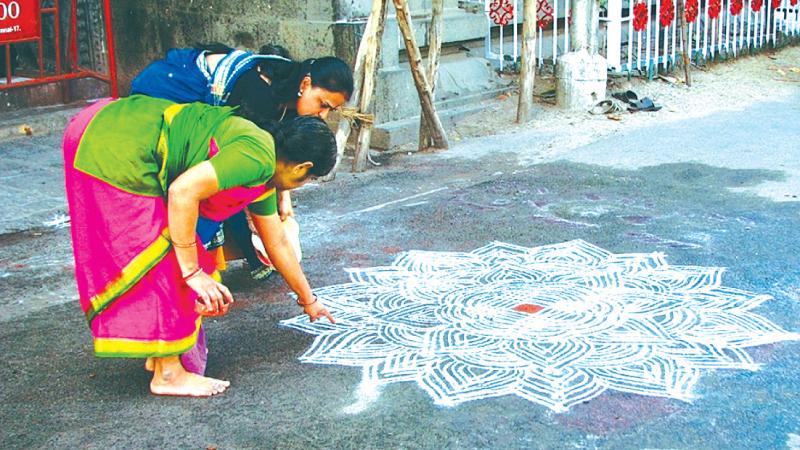
As the rituals and traditions of the Sinhala and Tamil New Year are gaining momentum, the art of creating kolam designs is fast becoming a lost skill. The kolam or rangoli as it is known in India is a trademark of all Hindu homes. Its concept can be traced back to many centuries, as it began as a humble housewife’s task to an elaborate platform of vibrant expression.
Kolam designs are laid out early in the morning almost coinciding with sunrise. Using grains of rice and other pulses the kolam also serves to feed ants and birds, who are enticed to the garden. The lively chirping of birds is a refreshing sound in the morning. Households where there are sisters and aunties used to take turns or make it a team affair in creating these striking patterns.
 As with all rituals, today urbanization has impressed on us a digitally dominated lifestyle where we attempt to somehow control time. We are all crowned with a sense of being busy. Thus, in Sri Lanka the task of patiently laying a kolam is now done mainly in the villages of the Northern Province, that too only for occasions.
As with all rituals, today urbanization has impressed on us a digitally dominated lifestyle where we attempt to somehow control time. We are all crowned with a sense of being busy. Thus, in Sri Lanka the task of patiently laying a kolam is now done mainly in the villages of the Northern Province, that too only for occasions.
The custom is also observed in other areas where Hindu communities live. But we can safely assume the art is obsolete in Colombo, as people begin to reside in high-rise apartments. I asked my friend Priya Rajendran a devoted Hindu and she says, ‘Kolam or rangoli originated from India. Today we don’t have time with our daily work routines to sit and make these intricate designs. Yet there are a few older ladies who want to sustain this tradition.
Even in the kovils it is not displayed commonly as before, and is reserved for special days of religious significance’. Just like Priya, there are hundreds of other Hindu ladies in Colombo who have their daily routines, and time is a valuable commodity.
Rangoli designs are associated with a myth from India which says, that Andaal worshipped Lord Thirumaal and was married to him in the month of Margazhi. So during this month, unmarried girls get up before dawn and draw a Rangoli to welcome and venerate god Thirumaal.
Mentions of rangoli creations are also found in Hindu mythology. In the epic romance captured in Ramayana at Sita’s jubilant wedding pavilion, there is reference to rangoli designs. Cultural appreciation of Rangoli in the South originated in the era of the majestic Chola Rulers.
There are modern and traditional rangoli designs. The designs are usually inspired by nature, but they can also be expressed as abstract art. Shape, design and material can be influenced by regional traditions and the skill of the person laying the design. A square grid is common in North India as is a hexagonal grid is the expression of South India; Onam Rangolis are typically circular.
In North India, the colour is most often based on gypsum (chirodi), in the South India states rice flour and Onam Rangolis are typically flower based, which enhance the doorway or entrance to a home.
The influence of widespread migration and integration of people within India can be seen by the way these styles are now freely adopted. It is a new trend to witness sawdust-based floating Rangolis, freeform designs and exotic materials.
In Sri Lankan homes where the ritual is maintained amidst challenges, the designs are brought to life using coloured rice, dry flour, flower petals, turmeric, vermillion and coloured sand which is dyed in advance.
The patterns include the face of Hindu deities, peacock motifs and floral designs.
I have seen tourists getting excited at these designs, as they are awed by this unique art form. Even the serene homes in Jaffna are now busy and the kolam remains elusive. Many of these motifs are traditional and are handed down by generations.
Kolams are considered a sign of prosperity. Will this ritual fade away and become a cultural memory?
